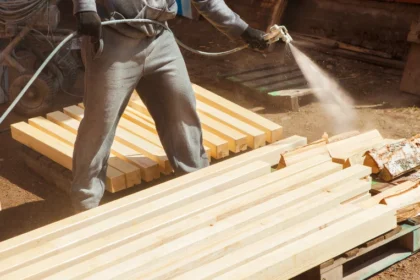
Wood is a popular and versatile material used in many construction projects. It’s often used to build important parts of buildings like walls, ceilings, and floors, as well as other parts like doors, frames, and cladding. However, wood can easily catch fire and needs special protection like fire retardant coating.
These coatings work by actively slowing the spread of flames across the surface of the wood. This delay allows more time before the fire reaches the core material or substrate. In this blog, we will discuss how fire retardant coatings function, what benefits you can get, and provide step-by-step guidance on properly applying these coatings to ensure maximum safety and effectiveness.
How Does Fire Retardant Coating Work?
When subjected to high temperatures, the specialized compounds within flame retardant coatings, generally consisting of phosphorus or nitrogen, undergo a chemical reaction with oxygen and water vapor present in the environment. This reaction results in the formation of a dense, insulating foam. This foam not only acts as a physical barrier, delaying the transfer of heat and thus the spread of flames, but it also helps reduce oxygen availability near the burning surface.
By limiting oxygen, it curtails the flammability of the material it protects. This technology is particularly effective when applied to wooden materials commonly found in both commercial and residential properties. Items such as plywood panels, various types of furniture, and wooden doors can be coated with flame retardant paints to enhance their resistance to fire.
Benefits of Using Fire-Retardant Treated Wood
There are several advantages of using wood, which is treated with fire retardant coating. Some of them are listed below:
- FRTW is suitable for both interior applications, including environments with high humidity, and exterior construction projects.
- Fire retardant coating complies with different ASTM safety standards and passes through rigorous tests, including the Room Corner Test, ensuring compliance and safety in high-risk fire zones.
- In construction projects, using FRTW eliminates the need for sprinkler systems, reducing overall construction costs.
- Using fire retardant paint on wood can also save you money on insurance. Since it helps to prevent major fire damage, insurance companies might offer you a discount on your premiums. This is because the risk of costly claims is reduced.
- When ignited, fire treated wood generates significantly less smoke compared to untreated wood, enhancing safety during a fire.
- The treatment process for FRTW utilizes water-based, non-toxic chemicals, making it an environmentally responsible choice.
- These woods maintain their structural strength at higher temperatures than steel, offering reliable performance under fire conditions.
How to Apply Fire Retardant Coating on Wood?
Before you begin the application process for fire retardants, it is crucial to prepare properly by collecting the appropriate materials. When selecting a fire resistant coating, ensure it is appropriate for the type of wood you intend to treat and complies with existing safety standards and regulations.
You will also require the following essential items:
Protective Gear: Prioritizing safety is essential when working with chemicals. Equip yourself with the necessary protective gear, including safety glasses, gloves, & a mask, to protect against potential chemical exposure.
Applicator: The application method will vary depending on the chosen fire retardant product. It could be a roller, brush, or a spray gun. Select an applicator that is compatible with the texture and area of the wood surface you are treating.
Clean Cloth: Have a clean cloth readily available to address any accidental spills or to remove any excess fire retardant from the wood surface.
Ventilation: To minimize inhalation of fumes, ensure the workspace is well-ventilated. If you are working indoors, use fans or open windows to promote adequate air circulation.
Steps to Apply Fire Retardant on Wood
With all the necessary materials at hand, follow these detailed steps to apply fire retardant on wood effectively:
Step 1 – Preparation
Start by completely cleaning the wooden surface to remove all dust, dirt, or debris. A clean wooden surface will enhance the adhesion of the fire retardant. If the wood has previous treatments or paint, lightly sand it to prepare a more receptive surface for the new application.
Step 2 – Protection
Protect any nearby surfaces or areas that you do not wish to treat with fire retardant. Use plastic sheets or cloths to cover surrounding objects and maintain a clean work environment. Safety should always remain a central concern throughout this process.
Step 3 – Application
Apply the fire retardant as per the manufacturer’s instructions. Use the chosen method—be it spraying, painting, or coating—to ensure thorough and even coverage. Focus on covering joints, corners, and other areas that are particularly vulnerable to fire exposure meticulously.
Step 4 – Drying Time
Allow the applied fire retardant to dry completely. The drying period may vary based on the fire retardant type and the environmental conditions. Adhere strictly to the recommended drying time provided by the manufacturer to maximize the treatment’s effectiveness.
Is Fire Retardant Wood Considered Non Combustible?
It’s clear that wood forms a fundamental component of nearly every piece of furniture in homes and businesses. Property owners favor wood for its ability to create a warm, inviting atmosphere that adds comfort and aesthetic appeal.
However, wood’s natural composition, rich in cellulose and lignin, makes it highly flammable. Generally, fire hazards begin with a source of ignition, such as wildfires or electrical faults, which can quickly spread to nearby combustible materials, including wood.
Fortunately, using fire-retardant wood can reduce the risks and damage of fires. It’s important to note, though, that while fire-retardant wood burns more slowly than untreated wood, it is not entirely non-combustible and can still sustain some fire damage.
Conclusion
Fire retardant coating for wood enhances fire safety by slowing flame spread and reducing oxygen availability. Proper application ensures effective protection, making it a valuable safety feature for wooden structures in different properties and potentially lowering insurance costs.
Firefree Coatings provides fire retardant coatings that offer enhanced protection for wood in various applications. Our fire resistant coatings are formulated to meet the highest safety standards and provide exceptional fire resistance. With us, you can trust that your wooden structures are safeguarded against the devastating effects of fire. Call us to make an order!


